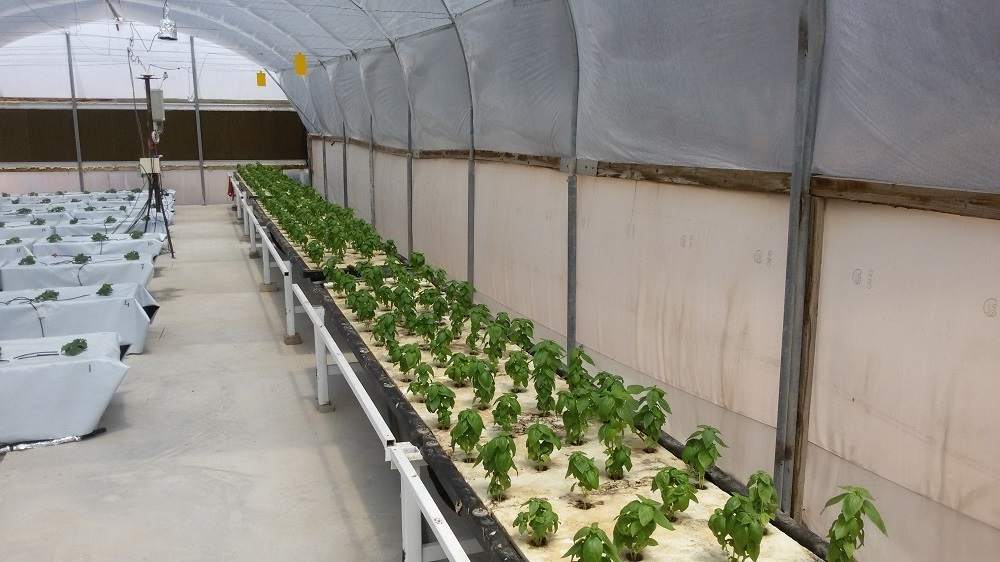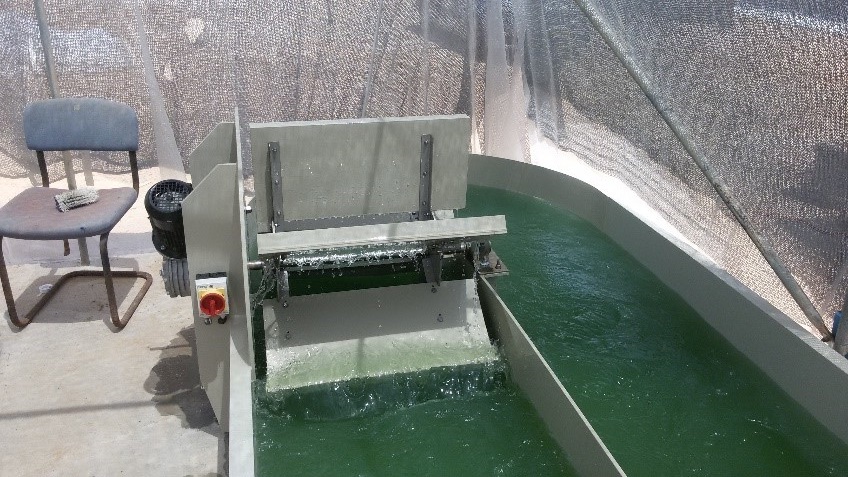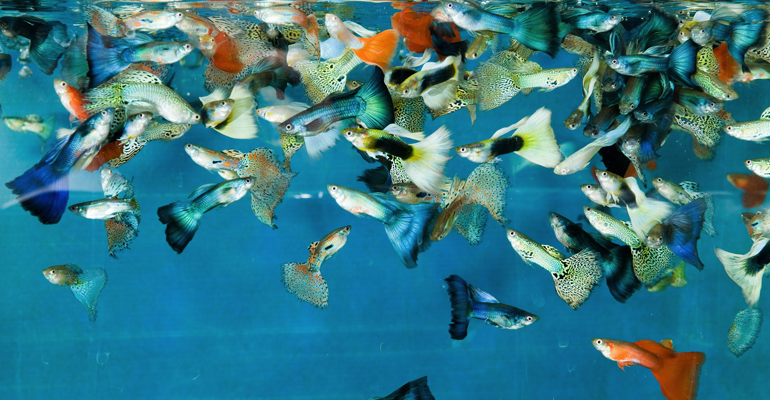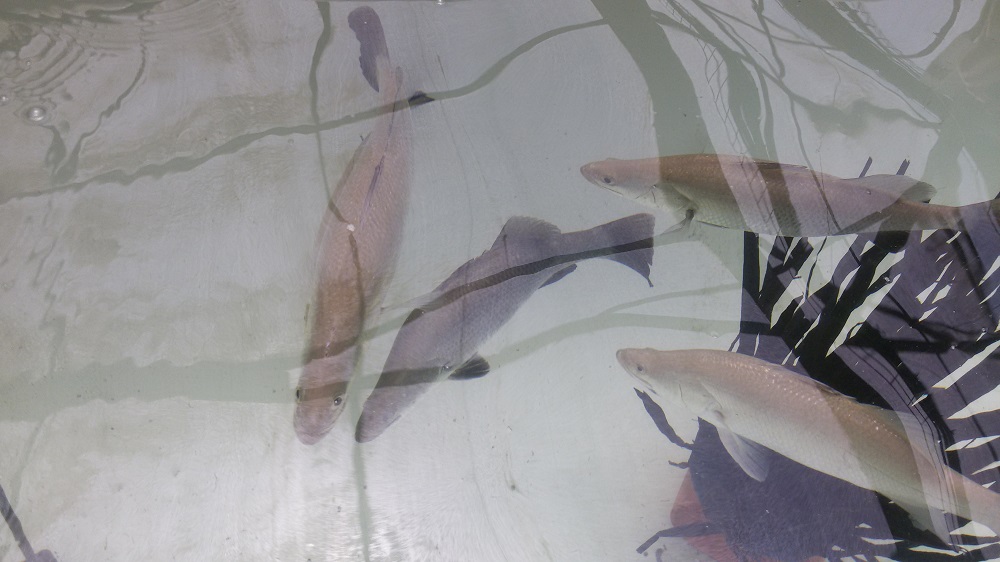Aquaculture
Aquaculture is a unique field in the Arava. Today, several farms produce and export ornamental fishes (mainly guppies, angelfish and clown fishes) to Europe. Our department operates on three levels of research: short term (months to a year) experiments that support local farmers in improving yield and quality of existing species. Mid-term studies (a year to two years) that endeavor in bringing new species and developing their rearing and breeding protocols to increase export opportunities for existing and new farmers in the region. Thirdly, we conduct studies in the other fields of aquaculture to offer alternatives to the current production. These studies are long-term and aim to get results in several years.
Our current projects include: search for freshwater alternatives to artemia as life feed for larvae, implementing breeding protocols for ornamental tetra species such as the cardinal tetra (see photo). Integrated aquaculture of edible fish and vegetables and production of micro algae.
Management
Recent Reports
-
12yearsago
Effect of population density on platy fish (Xiphophorus maculates)
Aquaculture20
תחום או ענף דגים
תאריך עדכון 14/3/2012Effect of population density on platy fish (Xiphophorus maculates)
Nitzan Reiss Hevlin, Tal Gur, Moti Userovich and Dan Popper - Central and Northern Arava R&D
E-mail address for correspondence: nitzanr@arava.co.ilAbstract
Platyfish (Xiphophorus maculates) are a popular species for home aquariums; these social animals live in schools and are pretty. They are omnivorous and give birth to live young. On farms, the faster the fish grow, the more crowded they get and the lower the costs to the grower — and the greater his profit margin. The process of ramping up production requires a significant increase in the number of fish per unit volume. There is a delicate balance between increased density, which allows for maximal use of the area, and preserving the health of the fish and their growth rate. Density is a source of chronic stress that is expressed in different ways depending on the type of fish, their age and their gender.
In an experiment conducted at the Yair Research Station during 2010/11, we evaluated the effect of the density of fish in an aquarium on their growth rate and survival. We did not find any difference in the growth of the fish at different population densities. However, we did see a difference in the survival rate at a density of one fish per liter as compared to 2.5 fish per liter.שפה English
מלות מפתח Ornamental fish, water quality
מחבר Nitzan Reiss Hevlin, Tal Gur, Moti Userovich, Dan Popper
שנה 2011
שייכות yzvieli
תאריך יצירה 14/3/2012
תאריך עדכון 14/3/2012 -
12yearsago
Use of concentrated brine for raising clownfish (Amphiprion ocellaris)
Aquaculture19
תחום או ענף דגים
תאריך עדכון 14/3/2012Use of concentrated brine for raising clownfish (Amphiprion ocellaris)
Nitzan Reiss Hevlin, Dan Popper, Tal Gur, Moti Userovitch – Central and Northern Arava R&D
E-mail address for correspondence: nitzanr@arava.co.ilAbstract
The market for ornamental saltwater fish has developed greatly in recent years and the demand for fish raised in captivity has increased. Clownfish (Amphiprion) are in great demand in the European market, where they are sold as ornamental fish for reef aquariums. They are valued for their pretty form and bold color, as well as their ability to live together with invertebrates in an aquarium. In recent years at the Yair Experimental Station of the Arava R&D Authority, a protocol has been developed for breeding and raising eight species of clownfish, including the most popular species, A. ocellaris. Currently, researchers at the Arava R&D Authority are focused on improving growth and breeding, adding new species to the set of saltwater fish currently raised in the region and reducing production costs. The main cost associated with raising saltwater ornamental fish in artificial environments is the cost of the water in which the fish are kept. Seven large desalination installations are currently used in the Arava to provide drinking water for local residents. Large amounts of brine flow from each of these installations to the sewer system. This brine is a byproduct of the desalination process and contains salt concentrations that are twice that of the local pipeline water. A previous study conducted at the Yair Experimental Station in 2010 examined the growth rate and survival of young clownfish raised in brine that was supplemented with sea salt as compared with those of fish raised in desalinated water or pipeline water supplemented with sea salt. There was no difference between the health and growth rate of the fish in the different treatments.
In the experiment on which we are currently reporting, which was conducted in 2011, we evaluated the growth rate and survival of clownfish raised in brine concentrated to a salinity level of 0.25 ppt. We did not notice any difference in the growth of the fish, but there was a significant difference in terms of survival.
Histological examination of the gills of these fish did not reveal any significant pathology in any of the treatment groups. The only difference between the groups was the form and quantity of chlorine cells.Acknowledgements
We thank the JCA Charitable Foundation for their financial support for this research. Thank you to Prof. Shanan Herpaz and Dr. Avner Canaani for their help planning the study. Thank you to Dr. Dina Zilberg, Dr. Gilat Sharon and Tamar Sini for examining the fish after the experiment. We thank the Arava staff of Mekorot, especially Yuval Plaout and Yoav Moyal for their cooperation, patience and generous assistance. We thank the staff of the Hetzva Field School for their understanding and patience.שפה English
מחבר Nitzan Reiss Hevlin, Dan Popper, Tal Gur, Moti Userovitch
שנה 2011
שייכות yzvieli
תאריך יצירה 14/3/2012
תאריך עדכון 14/3/2012 -
12yearsago
Enriching feed for molly fish (Poecilia velifera) with pigments
Aquaculture18
תחום או ענף דגים
תאריך עדכון 14/3/2012Enriching feed for molly fish (Poecilia velifera) with pigments
Nitzan Reiss Hevlin, Tal Gur, Moti Userovich and Dan Popper – Central and Northern Arava R&D
E-mail address for correspondence: nitzanr@arava.co.ilAbstract
The color of fish has a determinative effect on their beauty and how in demand they are in the market. A diet that includes pigments affects the color of the fish. In nature, the fish acquire pigments from the algae and aquatic microorganisms that they eat, but in closed systems used for breeding ornamental fish, it is customary to add coloring agents to the feed. In a series of experiments carried out at the Yair Experimental Station during 2011, we evaluated different types of coloring agents, both natural and synthetic, to determine which should be added to the fish feed. In a previous experiment in which coloring agents were added to the feed of molly fish (Poecilia velifera), good results were obtained from three different coloring agents: Haematococcus pluvialis, Capsantal and carophyll pink. Of these, we included the latter two in a further experiment that also included three types of feed. We found that for gold and orange mollies, the coloring agent Capsantal and BioMar feed provide the best results.שפה English
מחבר Nitzan Reiss Hevlin, Tal Gur, Moti Userovich, Dan Popper
שנה 2011
שייכות yzvieli
תאריך יצירה 14/3/2012
תאריך עדכון 14/3/2012








